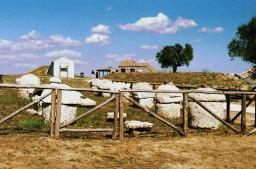A selection of astonishing Etruscan masterpieces has returned to Italy for the first time in centuries to star in new exhibition in this central Italian town.
The Hermitage has loaned Italy 30 Etruscan finds of extraordinary beauty and value, which spent many years in the hands of private Russian collectors before ending up in the St Petersburg museum.
The centrepiece of the show at the Etruscan Academy Museum of Cortona (MAEC), which runs until January 11, is a precious bronze statue of a reclining youth, purchased by Tsar Alexander II in 1862.
Originally a funerary urn containing ashes, the hollow sculpture is considered extremely rare as most Etruscan finds are made of stone rather than metal.
The youth is shown reclining on a pedestal, his legs draped in a mantel. His left hand, which was meant to hold a goblet, is open, while his eyes were once decorated with inlay.
Experts have dated the piece to the 4th century BC, based on gold ornaments found inside the statue, now held at the Louvre in Paris, and the patterns engraved on the drapery and pedestal.
Another bronze item shows an Etruscan deity clad only in headgear and footwear, striding solemnly forward.
The selection also features some rare mirrors and a number of beautiful vases, some made of stunning black bucchero pottery and others engraved with red and black figures.
As well as choosing some of the most spectacular items from the Hermitage collection, curators were also keen to borrow pieces similar to recent discoveries unearthed at an important tomb near Cortona, where the exhibit is being held.
The tomb, called the Melone II, was only discovered in the 1990s and found to contain fragments of beautifully manufactured Greek vases, very similar to the Hermitage pieces.
Used as a burial chamber for several centuries, Melone II also contained golden necklaces, rock crystal, coloured glass beads, iron weapons and a dagger.
All these pieces are now held at MAEC, which is using the Hermitage exhibition to celebrate the opening of six new permanent display rooms.
The Etruscans lived mainly between the rivers Tiber and Arno in modern-day Umbria, Lazio and Tuscany, in the first millennium BC.
By the sixth century BC they had become the dominant force in central Italy, but repeated attacks from Gauls and Syracusans later forced them into an alliance with the embryonic Roman state, which gradually absorbed Etruscan civilization.
Most of what is known about the Etruscans derives from archaeology as the few accounts passed down by Roman historians tend to be hostile, portraying them as gluttonous and lecherous.
This problem is compounded by the fact that Etruscan cities were built almost entirely of wood and so vanished quickly, leaving little for archaeologists to investigate.









